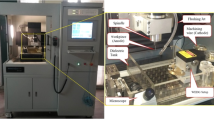Abstract
Wire electric discharge grinding has been developed to generate cylindrical profiles on hard-to-machine microparts. The outcome of the part is influenced by the process conditions and the rotational speed of the spindle. This paper investigates the effects of machining parameters on material removal rate (MRR), surface roughness and circularity during wire electrical discharge grinding process of tungsten carbide workpiece. Experiments have been carried out by varying process conditions such as peak current, open circuit voltage, pulse off time, servo voltage and number of passes. Pulse current has the highest significance to obtain maximum MRR. To obtain the best surface quality, pulse current, number of passes and pulse off time are identified as the most significant parameters. Using the technique of order preference by similarity to ideal solution, the optimal conditions estimated are pulse current (38 A), open circuit voltage (60 V) and pulse off time (24 µs) for finish machining.









Similar content being viewed by others
References
Masuzawa T, Fujino M, Kobayashi K, Suzuki T (1985) Wire electro-discharge grinding for micro-machining. Manuf Technol 34:431–434
Krishnan A, Samuel GL (2012) Multi-objective optimization of material removal rate and surface roughness in wire electrical discharge turning. Int J Manuf Technol 67:2021–2032
Rees A, Brousseau E, Dimov SS, Bigot S, Griffiths CA (2013) Development of surface roughness optimization and prediction for the process of wire electro discharge grinding. Int J Adv Manuf Technol 64:1395–1410
Zhang L, Tong H, Li Y (2015) Precision machining of micro tool electrodes in micro EDM for drilling array micro holes. Precis Eng 39:100–106
Matoorian P, Sulaiman S, Ahmad HM (2008) An experimental study for optimization of electrical discharge turning (EDT) process. J Mater Process Technol 204:350–356
Uhlmann E, Piltz S, Jerzembeck S (2005) Micro-machining of cylindrical parts by electrical discharge grinding. J Mater Process Technol 160:15–23
Balamurali D, Manigandan K, Sridhar V (2015) Analysis of the effects of machining parameters on wire electrical discharge turning of stainless steel. J Adv Eng Res 2:34–41
Qu J, Shih AJ, Scattergood RO (2002) Development of the cylindrical wire electrical discharge machining process, part 2: surface integrity and roundness. J Manuf Sci Eng 124:708–714
Yang RT, Tzeng CJ, Yang YK, Hsieh MH (2011) Optimization of wire electrical discharge machining process parameters for cutting tungsten. Int J Adv Manuf Technol 60:135–147
Zhang Z, Peng H, Yan J (2013) Micro-cutting characteristics of EDM fabricated high-precision polycrystalline diamond tools. Int J Mach Tools Manuf 65:99–106
Miller SF, Kao CC, Shih AJ, Qu J (2005) Investigation of wire electrical discharge machining of thin cross-sections and compliant mechanisms. Int J Mach Tools Manuf 45:1717–1725
Mohammadi A, Tehrani AF, Abdullah A (2013) Introducing a new technique in wire electrical discharge turning and evaluating ultrasonic vibration on material removal rate. Procedia 6:583–588
Mohammadi A, Tehrani AF, Emanian E, Karimi D (2008) Statistical analysis of wire electrical discharge turning on material removal rate. J Mater Process Technol 205:283–289
Alias A, Abdullah B, Abbas NM (2012) Influence of machine feed rate in WEDM of titanium Ti-6Al-4 V with constant current (6A) using brass wire. Procedia Eng 41:1806–1811
Song KY, Chung DK, Park MS, Chu CN (2013) EDM turning using a strip electrode. J Mater Process Technol 213:1495–1500
Rao PS, Ramji K, Satyanarayana B (2014) The experimental investigation and optimization of wire EDM parameters for surface roughness, MRR and white layer in machining of aluminium alloy. Procedia Mater Sci 5:2197–2206
Janardhan V, Samuel GL (2010) Pulse train data analysis to investigate the effect of machining parameters on the performance of wire electro discharge turning (WEDT) process. Int J Mach Tools Manuf 50:775–788
Phadke MS (1989) Quality engineering using robust design. Prentice-Hall International Inc., Upper Saddle River
Gologlu C, Sakarya N (2008) The effects of cutter path strategies on surface roughness of pocket milling of 1.2738 steel based on Taguchi method. J Mater Process Technol 206:7–15
Kivak T, Samtas G, Cicek A (2012) Taguchi method based optimisation of drilling parameters in drilling of AISI 316 steel with PVD monolayer and multilayer coated HSS drills. Measurement 45:1547–1557
Athreya S, Venkatesh YD (2012) Application of Taguchi method for optimization of process parameters in improving the surface roughness of lathe facing operation. Int Refer J Eng Sci (IRJES) 1:13–19
Jahanshahloo GR, Lotfi FH, Izadikhah M (2006) Extension of the TOPSIS method for decision-making problems with fuzzy data. Appl Math Comput 181:1544–1551
Author information
Authors and Affiliations
Corresponding author
Additional information
Technical Editor: Márcio Bacci da Silva.
Rights and permissions
About this article
Cite this article
Parthiban, M., Krishnaraj, V., Sindhumathi, R. et al. Investigation on manufacturing of microtools made of tungsten carbide using wire electric discharge grinding (WEDG). J Braz. Soc. Mech. Sci. Eng. 39, 3571–3580 (2017). https://doi.org/10.1007/s40430-017-0780-2
Received:
Accepted:
Published:
Issue Date:
DOI: https://doi.org/10.1007/s40430-017-0780-2




